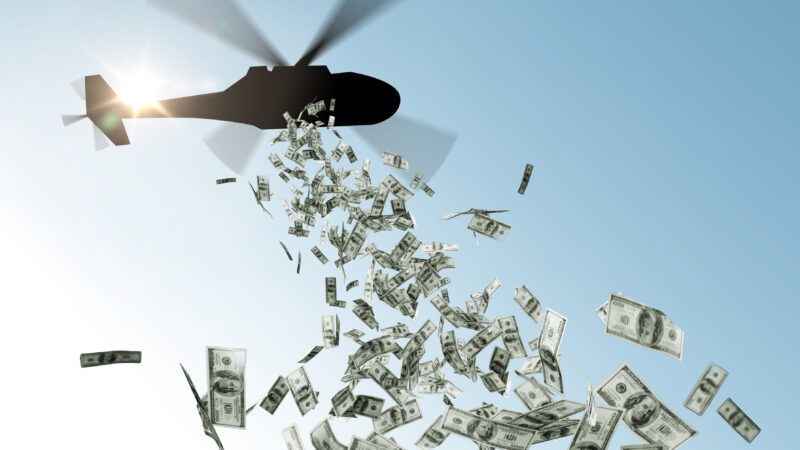Millions of PPP Loans Were Flagged as Potentially Fraudulent. Many Were Never Investigated.
A new report takes an illustrative look inside the Small Business Administration, which was clearly overwhelmed by the obligation to push unprecedented piles of money out the door quickly.

If the protesters who clashed with police and smashed their way through the U.S. Capitol on January 6, 2021, truly wanted to "stop the steal," perhaps their ire should have been directed a few blocks south.
While the chaos was unfolding at the Capitol, bureaucrats at the Small Business Administration (SBA)—three blocks away—were also apparently quite busy. According to a new report, some 1.8 million "flags" applied to loans issued as part of the Paycheck Protection Program (PPP) that indicated the loans might be fraudulent or otherwise incorrectly awarded were mass deleted from files on January 6.
The mass closure of those flags paved the way for billions of dollars of PPP loan debt to be forgiven in the final days of the Trump administration, seemingly without due diligence on the part of the federal bureaucrats charged with preventing fraud.
In all, the SBA flagged nearly 2.3 million PPP loans worth at least $189 billion, according to the report published Thursday by the Project on Government Oversight (POGO), a watchdog group that obtained those data from the SBA via an open records request. "A flagged PPP loan does not necessarily mean there was fraud, but some flags—if accurate—indicate clear-cut reasons a recipient would have been ineligible for the taxpayer-backed loan," the report explains.
But the SBA has now cleared 95 percent of those loans. More than 40 percent of the clearances occurred on January 6, far more than on any other single day. "That means a substantial number of loans flagged as potentially going to fraudsters or ineligible recipients have now been forgiven," the POGO report concludes.
Perhaps that's why other reviews of the program have found that as much as $100 billion of the $820 billion distributed via PPP loans was stolen by fraudsters.
There were 57 different types of flags applied to various PPP loans, according to the report. The most common one indicated that the business applying for the loan did not exist before February 15, 2020—the cutoff date for applicants that was supposed to prevent fraudsters from starting new businesses to collect pandemic aid. That flag was applied to 785,089 loans.
Any loan exceeding $2 million was automatically flagged for review under a Department of Treasury policy adopted in 2020 to apply stricter scrutiny to the largest PPP loans. But the POGO report shows that 99 percent of the roughly 28,000 loans flagged for that reason were cleared during the waning days of the Trump administration in January 2021.
"The bulk closure of most of these flags" the POGO report states, "suggests that not all of these large loans received the 'full review' that then-Treasury Secretary Steven Mnuchin pledged they would get."
The details of the POGO report are worth reading in full. It is an illustrative look inside a government bureaucracy that seems to have been overwhelmed by the obligation to push unprecedented piles of money out the door. In the first 33 days after the PPP program was opened in April 2020, the SBA lent out more than 20 times as much as it had handled in any full year before that time. High levels of fraud and waste were inevitable.
Even when the money did go to an eligible, actual business, much of it ended up in the pockets of business owners—rather than the paychecks of employees—at tremendous cost to taxpayers.
"Only 23 to 34 percent of the program's funds went directly to workers who would have otherwise lost their jobs," a National Bureau of Economic Research study found. Another study by the Federal Reserve Bank of St. Louis found that taxpayers paid roughly $4 for every $1 of wages and benefits to workers.
"Initially, the PPP promised loan refundability to businesses that kept workers on their payrolls for eight weeks, essentially converting those loans into grants," Reason's Peter Suderman detailed in February. "But, as the pandemic dragged on and the program was topped up with additional funds, the requirements slipped, and the PPP eventually turned into something more like an all-purpose federally funded slush fund for small business owners."
In a report published in May, the SBA's inspector general pointed out that the agency did not have "a centralized entity to design, lead, and manage fraud risk" until February 2022—nearly two years after the PPP loans began being distributed and long after the bulk of them had been forgiven. That's obviously far too late to do much.
"The millions of flagged PPP loans worth billions of dollars," the POGO report concludes, "and the lack of scrutiny leading up to their forgiveness, shows the great pandemic swindle was aided and abetted by the SBA's lax oversight."
